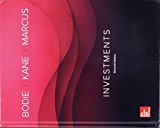
a.
To evaluate: The reason behind small firms having relatively high loadings on the SMB factor.
Introduction:
SMB Factor: SMB, when expanded, is small minus big. When a return on portfolio related to small stocks is earned more than the return on portfolio related to large stocks it can be termed as SMB.
HML factor: When the return on a portfolio of high book to market stocks is more than the low book to market stocks, that particular portfolio is considered as HML.
b.
To evaluate: The stock market behavior of the merged firm to differ from that of a portfolio of two previously independent firms.
Introduction:
SMB Factor: SMB, when expanded, is small minus big. When a return on portfolio related to small stocks is earned more than the return on portfolio related to large stocks it can be termed as SMB.
HML factor: When the return on a portfolio of high book to market stocks is more than the low book to market stocks, that particular portfolio is considered as HML.
c.
To evaluate: The effect on merger after market capitalization.
Introduction:
SMB Factor: SMB, when expanded, is small minus big. When a return on portfolio related to small stocks is earned more than the return on portfolio related to large stocks it can be termed as SMB.
HML factor: When the return on a portfolio of high book to market stocks is more than the low book to market stocks, that particular portfolio is considered as HML.
d.
To evaluate: The prediction of the FAMA-French model for the risk premium on the merged firm compared to the weighted average of two-component companies.
Introduction:
SMB Factor: SMB, when expanded, is small minus big. When a return on portfolio related to small stocks is earned more than the return on portfolio related to large stocks it can be termed as SMB.
HML factor: When the return on a portfolio of high book to market stocks is more than the low book to market stocks, that particular portfolio is considered as HML.
e.
To evaluate: The problems faced by the application of the FF model in case of a merger.
Introduction:
SMB Factor: SMB, when expanded, is small minus big. When a return on portfolio related to small stocks is earned more than the return on portfolio related to large stocks it can be termed as SMB.
HML factor: When the return on a portfolio of high book to market stocks is more than the low book to market stocks, that particular portfolio is considered as HML.
Want to see the full answer?
Check out a sample textbook solution
Chapter 10 Solutions
Investments, 11th Edition (exclude Access Card)
- Hello tutor this is himlton biotech problem.arrow_forwardYan Yan Corp. has a $2,000 par value bond outstanding with a coupon rate of 4.7 percent paid semiannually and 13 years to maturity. The yield to maturity of the bond is 5.05 percent. What is the dollar price of the bond?arrow_forwardA trip goa quesarrow_forward
 EBK CONTEMPORARY FINANCIAL MANAGEMENTFinanceISBN:9781337514835Author:MOYERPublisher:CENGAGE LEARNING - CONSIGNMENT
EBK CONTEMPORARY FINANCIAL MANAGEMENTFinanceISBN:9781337514835Author:MOYERPublisher:CENGAGE LEARNING - CONSIGNMENT

